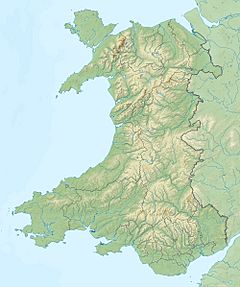Long Hole Cave facts for kids
| Location | between Paviland and Port Eynon |
|---|---|
| Region | Wales |
| Coordinates | 51°32′34″N 4°14′5.6″W / 51.54278°N 4.234889°W |
| Type | limestone cave |
| Site notes | |
| Excavation dates | 1861, 1969 |
| Archaeologists | E. R. Wood, J. B. Campbell |
Long Hole, also called Longhole, is a special limestone cave. It is found on the south coast of the Gower Peninsula in Wales. The cave is located between two places called Paviland and Port Eynon.
Long Hole is not very big, only about 15 meters (or 50 feet) deep. Even though it's small, it's very important for understanding early human history in Britain. Scientists have dug here twice to find clues about the past.
Contents
What is Long Hole Cave?
Long Hole is a natural cave formed in limestone rock. Over thousands of years, water slowly carved out the cave. It's like a natural shelter that ancient people might have used.
Where is Long Hole Cave?
The cave is on the Gower Peninsula, which is a beautiful coastal area in Wales. This area is known for its stunning beaches and cliffs. The cave's location near the sea would have been useful for early humans.
Discovering Ancient Life
Archaeologists are like detectives who study the past. They dig carefully to find objects and remains left behind by people long ago. This digging is called an excavation.
First Dig: 1861
The first time Long Hole was explored was in 1861. A person named Colonel E. R. Wood led this early excavation. He found some exciting things inside the cave.
- Stone Tools: Colonel Wood found a "lithic assemblage." This is a fancy way of saying he found a collection of stone tools. These tools show that early humans were living and working in the cave.
- Animal Bones: He also found "faunal remains," which are animal bones. These bones tell us what kinds of animals lived in the area a very long time ago.
Animals of the Ice Age
The animal bones found in Long Hole were from creatures that lived during the Ice Age. Imagine seeing these huge animals!
- Cave hyena
- Reindeer
- Woolly rhinoceros
- Mammoth
- Straight-tusked elephant
- Wild horse
These animals tell us about the climate and environment of Wales thousands of years ago.
Second Dig: 1969
Many years later, in 1969, another archaeologist named J. B. Campbell did more digging. This second excavation helped scientists learn even more.
- More Evidence: Campbell's team looked at the dirt (sediment) and even tiny bits of plant pollen. They also studied the stone tools more closely.
- Connecting the Dots: By putting all the clues together, scientists realized something amazing. Long Hole was a very important site from a time called the Aurignacian period.
Who Lived Here?
The Aurignacian period was a time when the first modern humans arrived in Europe. This was about 40,000 to 28,000 years ago.
Early Modern Humans
The discoveries at Long Hole show that modern humans were living in Britain during this ancient time. They were skilled hunters and toolmakers.
Link to Paviland
Long Hole is closely connected to another famous site nearby called Paviland. The "Red Lady" is actually the skeleton of a young man, stained red with ochre. He lived around the same time as the people who used Long Hole. Both sites give us clues about these early humans.
Why is Long Hole Important?
Long Hole is a key archaeological site. It helps us understand how and when the first modern humans came to Britain. The tools and animal bones found here paint a picture of their lives. They show us what they ate, what tools they used, and what their world was like.



